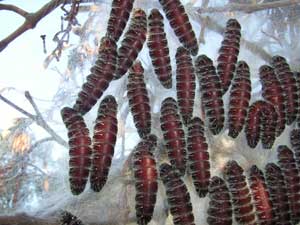Mistletoes and butterflies
 |
Mistletoes as food plants for Butterflies
The use of mistletoes as food plants by butterflies has generated a whole field of research which spans several continents. In Africa, for example, caterpillars of the genus Mylothris feed almost exclusively on plants of the order Santalales, and within the Santalales 65-80% of feeding records are on species of Loranthaceae. In Indonesia-Australia the situation is similar, with caterpillars of the genera Delias and Ogyris feeding on Santalales, and in Delias 77% of feeding records are on loranths. Other examples include the Catasticta group of genera, feeding on mistletoes in the neotropics, and the Hesperocharis group in South America.
It has been suggested that this predilection in butterflies for mistletoes as food plants is a derived state with multiple origins. It is thought that the original food plants may have been the host trees, and that perhaps through defoliation of the host, or egg-laying near mistletoe plants, there was a shift to the parasite as food plant. Given that mistletoe leaves may have higher nitrogen and mineral nutrient levels and fewer toxins than the host’s, natural selection may have favoured butterflies which preferentially lay their eggs on mistletoes.
Examples of butterflies from these genera and the food plants recorded for their caterpillar stages can be seen at the link below.
Visit another website on Australian caterpillars and mistletoes by Don Herbison-Evans and Stella Crossley.
![An Australian Government Initiative [logo]](/images/austgovt_brown_90px.gif)





